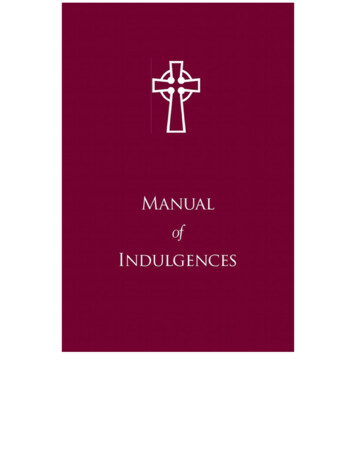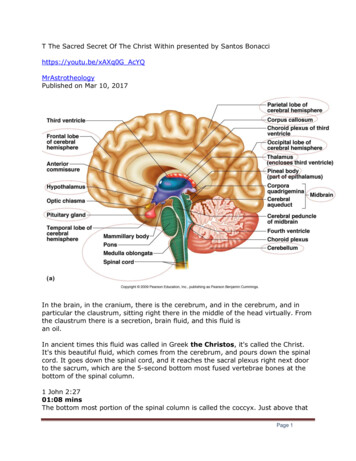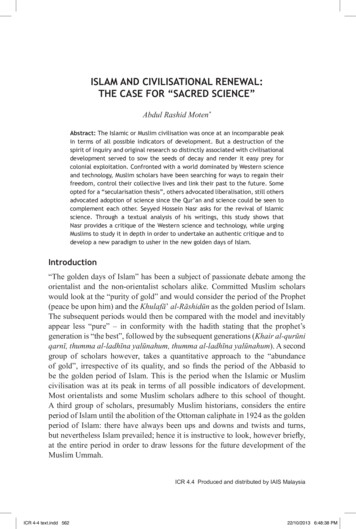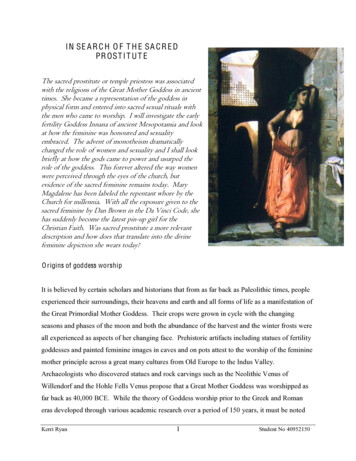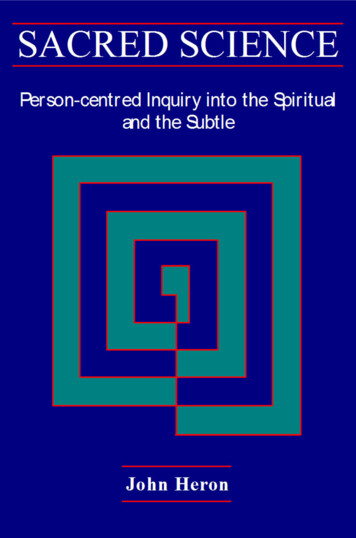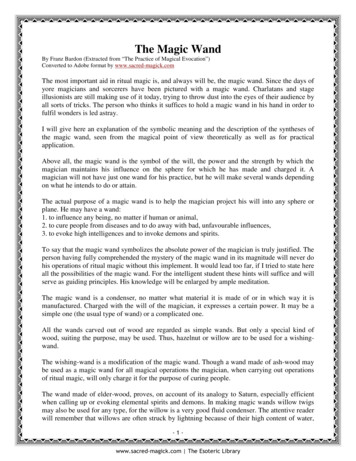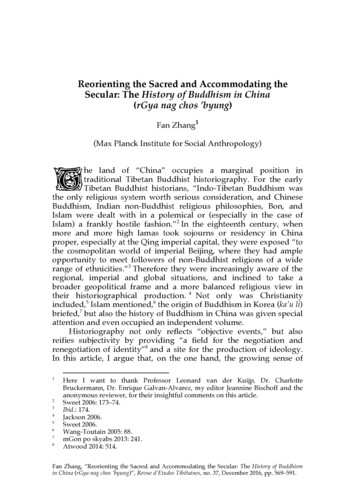
Transcription
Reorienting the Sacred and Accommodating theSecular: The History of Buddhism in China(rGya nag chos ’byung)Fan Zhang1(Max Planck Institute for Social Anthropology)The land of “China” occupies a marginal position intraditional Tibetan Buddhist historiography. For the earlyTibetan Buddhist historians, “Indo-Tibetan Buddhism wasthe only religious system worth serious consideration, and ChineseBuddhism, Indian non-Buddhist religious philosophies, Bon, andIslam were dealt with in a polemical or (especially in the case ofIslam) a frankly hostile fashion.”2 In the eighteenth century, whenmore and more high lamas took sojourns or residency in Chinaproper, especially at the Qing imperial capital, they were exposed “tothe cosmopolitan world of imperial Beijing, where they had ampleopportunity to meet followers of non-Buddhist religions of a widerange of ethnicities.”3 Therefore they were increasingly aware of theregional, imperial and global situations, and inclined to take abroader geopolitical frame and a more balanced religious view intheir historiographical production. 4 Not only was Christianityincluded,5 Islam mentioned,6 the origin of Buddhism in Korea (ka’u li)briefed,7 but also the history of Buddhism in China was given specialattention and even occupied an independent volume.Historiography not only reflects “objective events,” but alsoreifies subjectivity by providing “a field for the negotiation andrenegotiation of identity”8 and a site for the production of ideology.In this article, I argue that, on the one hand, the growing sense of12345678Here I want to thank Professor Leonard van der Kuijp, Dr. CharlotteBruckermann, Dr. Enrique Galvan-Alvarez, my editor Jeannine Bischoff and theanonymous reviewer, for their insightful comments on this article.Sweet 2006: 173–74.Ibid.: 174.Jackson 2006.Sweet 2006.Wang-Toutain 2005: 88.mGon po skyabs 2013: 241.Atwood 2014: 514.Fan Zhang, “Reorienting the Sacred and Accommodating the Secular: The History of Buddhismin China (rGya nag chos ’byung)”, Revue d’Etudes Tibétaines, no. 37, December 2016, pp. 569–591.
570Revue d’Etudes Tibétaines“being the cosmopolitan elites” among the Tibetan Buddhistintellectuals added gravity to their rapidly expanding worldview anda new centre to their historiography. By producing sacred historyand geography in China, they reoriented to the “Eastern Land” as asource of empowerment to accommodate the emerging preeminenceof Qing power in the Tibetan Buddhist world. On the other hand, Iargue that this “cosmopolitan identification”9 was accompanied bythe concomitant religious, ethnic and regional identifications. Bycreating new ways of political legitimation and subordinating theConfucian deities, such as the War Lord Guandi,10 to the TibetanBuddhist system, they contested the Confucian orthodoxy andnegotiated with the imperial power centre to claim spiritual andintellectual superiority. To further examine this reorienting andnegotiating process, I choose to investigate The History of Buddhism inChina (rgya nag gi yul du dam pa’i chos dar tshul gtso bor bshad pa blo gsalkun tu dga’ ba’i rna rgyan ces bya ba bzhugs so, or simply rgya nagchos ’byung), written by mGon po skyabs (c.1690–1750).1. mGon po skyabs and the Cosmopolitan Textual ProductionmGon po skyabs was born in a noble family of the Ujimcin Mongols,a subgroup of the Chahar Mongols in present day Inner Mongolia. In1637 the Ujimcin Mongols surrendered to the Manchus and latermGon po skyabs’ family was granted the ducal rank (gong 公) by theKangxi Emperor.11 mGon po skyabs inherited this title in 169212 andmarried into the lineal Manchu royal family in 1709. In 1715, due tounknown reasons, he volunteered to take military service as penalty.However, he was spared any serious punishment and instead he wasonly degraded from the rank of Gong to the rank of Taiji (台吉).Meanwhile he was appointed the “head of the Tibetan school(Tanggute Xue 唐古特学).”13 At this position, he “was responsible for910111213See Wang-Toutain’s (2005) illustration of various scholarship of differenttraditions participated in shaping the politics at the imperial capital; also see thetheorisation of Qing cosmopolitanism in the edited book (Hu and Elverskog2016).The widespread of the Guandi cult in various Chinese official and popularreligions makes it difficult to justify Guandi as a pure and exclusive Confuciandeity. Nevertheless, in this article I focus mainly on Qing’s effort to ConfucianiseGuandi. Hence the term Confucian deity here refers to the divine bureaucracyand its associated divinities.Wang-Toutain 2005: 60; Mala 2006: 145; Uspensky 2008; Wuyunbilige 2009: 120.Wuyunbilige 2009: 121.Ibid.: 122. Tanggute Xue was also called Xifan Xue (西番学) in some literatures. Itwas established in 1657 for the training of Tibetan language (Gangcuo 2010: 28).
The History of Buddhism in China571Tibetan studies and translations of Tibetan and Mongol texts.” 14Besides Mongolian, Tibetan and Manchu language, he “had completemastery of Chinese.” 15 He called himself “the upasaka Gombojabfrom the Land of Winds, who speaks four languages.”16Despite his Mongol origin and Manchu affinitiy, mGon po skyabswas well embedded in the Tibetan intellectual community of the time.He had frequent correspondences with Tibetan high lamas like kaHthog rig ’dzin Tshe dbang nor bu (1698–1755). 17 In fact, manyinfluential intellectuals of Tibetan Buddhism were not ethnic Tibetanaccording to today’s classifications, such as Sum pa mkhan po Yeshes dpal ’byor (1704–1788) and lCang skya khutukhtu Rol pa’i rdorje (1717–1786). However, they were enrolled in the Tibetan Buddhisteducation system, contracted master-disciple relationship with highlamas in Tibet, possessed the required language proficiency to writein Tibetan, and contributed to the development of Tibetan literature.As Pamela Crossley suggests, by retrospectively endowing historicalentities with the contemporary concept of ethnicity or nationalism,we are liable to overlook identity as a process and misunderstandindigenous criteria of identity. 18 In the eighteenth-century QingEmpire, the formation of cosmopolitan intellectuals and the sense of“being the ruling elites” intersected with regional, ethnic andreligious variations. It created a grey zone for different actors toappropriate power through negotiating and adjusting ethnic andreligious boundaries.mGon po skyabs composed the text of the History of Buddhism inChina at the requested of the Fifth Siregetü Khutugtu (1713–1751), asrevealed in the colophon.19 As one of the most politically influential141516171819In the imperial bureaucratic system of Qing, it belonged to Lifan Yuan (理藩院).Only those who were trained in the Tibetan language school were qualified towork for the government as translators or interpreters (Kanaoka 1992: 56). Forexample, in office of the imperial Resident Ministers in Lhasa, some positionswere filled with the students from the Tibetan language school.Mala 2006: 145.Sweet 2006: 175.“skad bzhi smra ba’i dge bsnyen rlung khams pa” (Uspensky 2008: 59).Tshe dbang nor bu 1973: 737–46. Tshe dbang nor bu was an active diplomat ofthe 7th Dalai Lama in the Himalayas, as well as a renovator of Buddhist sites inNepal, a power broker for the 12th Karmapa, and an acquaintance of lCang skyakhutukhtu (Ronis 2009: 86–99).Crossley 1999: 48–49.There are debates on when this work was composed and published. WangToutain dates it in 1735 (2005: 82); Vladimir Uspensky (2008: 61) and Fengxiao(2013: 8) point out that it was written in 1736; Japanese scholar Kanaoka Hideropoints out that this work was written in 1746 (1992: 56). Blo bzang bstan ’dzin(2013: 6) as well as Sun Lin and Chos ’phel (2009: 24) argue that it was composedat the end or at least in the later period of the eighteenth century.
572Revue d’Etudes Tibétaineslamas at that time, the Fifth Siregetü Khutugtu was appointed theChief Priest of the Yellow Temple (Huangsi 黄寺) in Beijing and theJasak Da Lama of Köke qota by imperial order.20 mGon po skyabswas one of his students. In the writing process, mGon po skyabsconsulted many important Tibetan historical texts 21 and also readextensively the relevant Chinese materials (ma hā tsi na'i rgyal rabs kyiyig tshang).22 The History of Buddhism in China “remained the mainsource concerning the history of China available to Tibetanreaders.” 23 In the nineteenth century, the influential scholar ’Jamdbyangs mkhyen brtse (1820–1892) proofread and printed it in theprestigious printing house of sDe dge (sde dge lhun grub steng du legspar bsgrubs).24Guilaine Mala has summarised the five chapters25 of the text andshe concludes that “the use of a Tantric prophecy and non-Tantricarguments [was] made by an eighteenth-century Mongol historian totransform and reinterpret the history of China in the light of his ownBuddhist beliefs.”26 I further demonstrate in this article the ways inwhich mGon po skyabs and the cosmopolitan Tibetan Buddhistintellectuals at large practiced multiple identifications, contested theintellectual sovereignty of the Confucian intelligentsia, reversed thesuperior-inferior hierarchy, and meanwhile participated in theproduction of Qing political legitimacy.2. Reproducing the Sacred Eastern Land of MahācinaThe History of Buddhism in China was started with the delineation of“China.” mGon po skyabs first took an etymological investigation:the Indians (’phags yul ba rnams) call China “ma hā tsi na,” in which mahā means great and tsi na is the phonetic transcription of the Chineseword “qin,” the Qin Dynasty (秦朝, 221–207 BC). mGon po skyabs20212223242526Mala 2006: 146; Ikejiri 2015. According to the study of Yoko Ikejiri, in the earlyeighteenth century, monks in Qinghai Region formed a close community. Theytook leading positions at the Qing court and connected the Tibetan clericcommunity and the central government.mGon po skyabs 2013: 262, 373. Such as the Blue Annals, the Origin of the BuddhistDharma and the Buddhist History of India.Ibid.: 376; Uspensky 2008: 59; Sun and Chos ’phel 2009: 24. Such as the Collectionof Biographies of the Honorable Monks (bla chen rnam thar, Gaosengzhuan 高僧传) andthe Catalogue of Chinese Buddhist Canons (sde snod gsum gyi dkar chag, Zhiyuanlu至元錄).Uspensky 2008: 61.mGon po skyabs 2013: 377.Mala 2006: 148–49.Ibid.: 164.
The History of Buddhism in China573then introduced the Chinese territory: to the East, China reaches tothe Eastern Sea; to the South, China is adjacent to Annam (an nan)and Champa (tan theng), both in present day Vietnam; the North andthe West are surrounded by the Great Wall (thang cheng). mGon poskyabs further explained the administrative divisions of the Chineseterritory: this vast land (yul gru chen po) was divided into thirteenprovinces (zhing); but now with the increase of population, there aresixteen provinces.27With these historical, geographical and administrative details,mGon po skyabs obviously referred “Ma hā tsi na” to a concrete geopolitical entity. It significantly differed from the mythical or esotericspace “ma hā tsi na” occupied in previous literature. When“Mahācina” appeared in Indian literature of the tenth and theeleventh centuries, it implied a region or state roughly located to thenorth of India.28 Tucci argues that as early as the seventh century theTibetans had already known “Cina is Tsi-na and refers to a specificregion adjacent to Spiti (to the northwest) and Uttarkasi (to thesoutheast) [of India].” 29 Despite Tucci’s assertion, the confusionsurrounding “Cina” and “Mahācina” lingered among the Tibetans fora long time. Taranatha (1575–1634) placed “Cina” and “Mahācina”amongst a group of mythical countries in the north of Jambudvipa onthe way to the legendary Shambhala 30 . Tibetan scholar GendunChopel points out that “Mahācina” was occasionally adopted by theTibetans abroad to refer to Tibet.31Until the mid-sixteenth century, a clear definition of “Mahācina”and its identification with China appeared in A Scholar’s Feast(chos ’byung mkhas pa’i dga’ ston):The land of China is called Mahācina, located in the northeast of thecontinent of Jambudvipa, reaching the ocean, and its territory is huge.According to the Root Tantra of Mañjuśrī, in the enlightened land,there is the King of Treasure. [ ] the illuminating Mañjuśrī manifestsas a child in this holy land, and resides in the Mount Wutai (the FivePeak Mountain). All the Enlightened ones such as Samantabhadrareside and enjoy in the Elephant Mountain.32272829303132mGon po skyabs 2013: 174.Cutler 1996: 43.Tucci 1971: 551.Tā ra nā tha 2008: 238.“[I]n Ogyenpa Ngawang Gyatso’s biography, he says to a brahmin, ‘I am not aKashmiri; I am a Tibetan coming from Mahacina.’ [ ] Some people say thatbecause, for many panditas in ancient times, the name for us, Tibet, was knownas Mahacina, the references to Mahacina in the Mañjuśrīmūlatantra must refer toTibet alone.” (Chopel et al. 2014: 356).dPa’ bo gtsug lag phreng ba 2006: 711.
574Revue d’Etudes TibétainesThis narrative was possibly modeled on the story of “the King ofTreasure” in China who lived for 150 years and the legend of themanifestation of Mañjuśrī as a child in China in the Origin of theBuddhist Dharma (bde gshegs bstan pa'i gsal byed chos kyi 'byung gnas).33However, the Origin of the Buddhist Dharma had not constructed theconnection among cina, mahācina and China, while A Scholar’s Feastexplicitly built the connection and elaborated upon the geographicalfeatures of China. In the late seventeenth century, the Fifth DalaiLama had a nuanced usage of the words. He used “ma hā tsi na”more in the sense of a political entity or territory, which oftenappeared in the combination “Ma hā tsi na’i rgyal khams” (thekingdom of Mahācina), while he used “rgya nag” more in the sense ofethnic belonging against other ethnic groups such as hor or sog.34 Inthe Crystal Mirror (grub mtha’ shel gyi me long), apparently Thu’ubkwan Blo bzang chos kyi ni ma (1737–1802) confirmed theconnection between Mahācina and China. Under the title “ma hā tsina’i yul du rig byed dang bon gyi grub mtha’ byung tshul,” Thu’u bkwanintroduced the history of various fields of learning and believes suchas Confucianism and Daoism in “the land/territory of China;” atother places of the book he used “rgya nag gi yul du nang pa sangsrgyas pa’i chos lugs” to emphasise “Chinese” Buddhism vis-à-vis“Tibetan” Buddhism.35The Sanskrit etymology of mahācina was “discovered” in theeighteenth century. When Tshe dbang nor bu introduced the“tradition of Hwa shang from China,” he suspected that “ma hā”should be the Sanskrit word “great” (chen po), but that the origin of“tsi na” was not clear and the “sign” (ri mo) of “tsi na” had manydifferent interpretations. 36 Intellectually well connected to Tshedbang nor bu, mGon po skyabs could have learnt this informationfrom the Tibetan intellectual community. It is also possible that helearnt the Sanskrit root of mahācina from Chinese literature. In theseventh century, both Cina and Mahācina were identified as “China”33343536Bu ston rin chen grub 1988: 144.For example, “byang na chos rgyal rigs ldan gyi zhing khams cha bsags kyi grong khyerchen po shambha la dang lha min las chad pa’i ’thab rtsod dpa’ bo’i gnas hor sog gi yu /shar na ’phags pa ’jum dpul gyi zhing ri bo rtse lnga sogs ma hā tsi na'i rgyal khams mirnams klu las chad pa rtsis dang nor gyi ’byung gnas rgya nag rnams kyi phyogs bzhinas mdzes shing shing kai la sha’i ra bas bskor ba’i yul” (Ngag dbang blo bzang rgyamtsho 2009: 167). It is quite obvious in this example that, “north” is incorrespondence to “east,” “Shambala” to “Mahācina,” and “hor” and “sog” to“rGya nag.”Blo bzang chos kyi nyi ma 2000: 421–482. In the lan kru’u edition (1984),however, it was all put under the title “ma hā tsi na.”Tshe dbang nor bu 2006: 379.
The History of Buddhism in China575in the Great Tang Records on the Western Regions (Datang Xiyu Ji 大唐西域记).37 Nevertheless, cina appeared in Chinese diversely as “Qin 秦,”“Jin 晋,” “Han 汉” and “Zhina 支那.” In the mid-seventeenth century,the Jesuit missionary Martino Martini (1614–1661) traced the origin of“cina” to “Qin”38 and it was popularised among Chinese intellectuals.mGon po skyabs was both familiar with Xuanzang’s work and themissionary work, which enabled him to relate “tsi na” with theChinese word “qin” from their phonetic similarity.In this sense, mGon po skyabs’ specification of Mahācina and Cinaand their final identification with China was the product of Qing’scosmopolitanism. Blo bzang chos kyi ni ma provided furtherexplanation on this point in his Crystal Mirror.39 When they renamedChina as Mahācina, they relocated the “Middle Kingdom” inBuddhist cosmology. This renaming and relocating process reflectedthe active participation in and appropriation of Qing’scosmopolitanism by the Tibetan intellectuals in the eighteenthcentury.3. Subordinating dao Under chosIn Chinese official dynastic historiography, Chinese rulers, be themof Han or non-Han origins, were portrayed as “Sage-kings”(shengwang 圣王). The idea of the “Sage-king” appeared in the fourthcentury BC and later was theorised in Mohist texts.40 The Confucianpolitical theory derived the legitimacy of the “Sage-king” from the“mandate of Heaven” (tianming 天命) and the “dao (the Way)” withan emphasis on virtuous deeds and its connection with supernaturalpower. 41 To subordinate it under the notion of the “cakravartin3738394041Zhang 1977: 451–453; Shi 1972: 450.Ibid.: 449.Blo bzang chos kyi nyi ma 1984: 391.Brown 2013: 143–174.The “mandate of Heaven” referred to the political legitimacy based on virtueinstead of birth (Puett 2002: 54–60). In reality, as Sarah Allan has illustrated, theclassic Chinese texts express quite conflicting ideologies of ruling by virtue andruling by heredity. She argues that what is unique to Chinese tradition is “theidea of dynastic cycle, in which one dynasty is founded by merit and then carriedon hereditarily until a depraved last king is overthrown by a good man, whothen establishes a new hereditary dynasty” (Allen 2015: 16). The idea of“mandate of Heaven” also enabled the Sage-kings to become “superhumanbeings whose wisdom allowed them to recognise the celestial patterns hidden innature and bring mankind into accord with them” (Lewis 1990: 167). The core ofthe dao in Confucian political theory normally referred to “humane government”(renzheng 仁政) (Tu 1985: 81–92), although throughout Chinese history violencewas mobilised more than virtue in order to gain power (Lewis 1990).
576Revue d’Etudes Tibétainesking,” mGon po skyabs firstly redefined the concept “dao” as dbangdha’u (wangdao 王道) and paa dha’u (badao 霸道). He explained that theformer implies that out of virtuous (yon tan) and altruistic (lhag bsam)intentions one achieves authority over a territory, where peopledepend on his virtous and altruistic rule and glorify him; the latterindicates that motivated by desire or sensual enjoyment (’dod pa) oneachieves power through military might (dpung stobs), destroying andinvading the others. mGon po skyabs asserted that dao, both aswangdao and badao, corresponded with Buddhist dharma (chos) andpath (lam).42 By this, mGon po skyabs implied that the Sage-king,following either the virtuous way (wangdao) or the military way(badao), ultimately followed the Dharma, and therefore, the ChineseSon of Heaven actually was the King of Treasure:He has many followers and strong power. He follows the Teacherextensively. He has many allies. Barbarians surrender and victoriesdescend. [ ] [He] lives long, up to 150 years, and ascends to the landof the gods. After fully mastering the essence of Dharma, he willachieve enlightenment.43By building the connection between “following the Teacher” andachieving imperial prosperity and personal longevity, mGon poskyabs changed the political legitimation of Chinese kingship fromthe “mandate of Heaven” to the Buddha’s blessing. More specifically,mGon po skyabs categorised Chinese rulers within the typology ofthe Buddhist kingship system as “cakravartinrājās” ruling with thepower of merit (bsod nams). As mGon po skyabs quoted from thebDen smra lung bstan pa’i mdo, “cakravartinrājā” was one of the fourtypes of kingship (rgyal po rnam pa bzhi). 44 Although cakravartinkingship was adopted by Chinese Buddhists in the sixth century and“mixed with the characteristics and traditional attributes of the Sonof Heaven”45, nevertheless, “it generally seems to be of rhetoricalnature and it is expressed neither in political claims nor in ritualpractices” 46 . The Mongolian rulers made an exception in thefourteenth century when they were directly called cakravartin-kings4243444546mGon po skyabs 2013: 177.Ibid.The four types are cakravartinrāja (’khor los sgyur ba’i rgyal po), overlord (rgyal pochen po), lord (khams kyi rgyal po), and chieftain (rgyal phran). (mGon po skyabs2013: 194).Zürcher 2013: 290. For example, the Buddhist Emperor Wu of Liang (464–549)was addressed as “Emperor Bodhisattva” (huangdi pusa 皇帝菩萨), “Bodhisattvawho Save the World“(jiushi pusa 救世菩萨) and Son of Heaven Bodhisattva (pusatianzi 菩萨天子).Ibid.
The History of Buddhism in rpoliticallegitimation.47 mGon po skyabs further placed the model of the Sageking under that of the cakravartin-king.mGon po skyabs applied his cakravartin-kingship to recount thepolitical history of China, in which the legend of the Emperor Wu ofHan was remodeled. Although based on Records of the Grand Historian(shiji 史记), mGon po skyabs rearranged the order of the story: theEmperor Wu of Han acquired a giant golden Buddha statue (ston pa’igser sku che ba zhig) from the hor as tribute; the Emperor placed thestatue of Buddha in the inner palace with great honor and dailyoffering; when the Emperor was making sacrifices on the centralpeak of the Five Mountains (lhun po lnga’i ri bo dbus mar), theauspicious phrase of “wan su’i” descended from the sky three times;then the Emperor killed an evil dragon in the Eastern Sea, made asacrifice with horse and jade to stop the twenty-years long flood ofthe Yellow River, and expanded his power greatly with his imperialedicts (’ja’ sa) and seals (tham ka) reaching the territory (gnas pa) offorty-thousand miles.48The insertion and the sequence of mGon po skyabs’ story isworthy of elaboration. By inserting the tale of the golden Buddhastatue in the beginning, mGon po skyabs alluded to the connectionbetween the Emperor’s Buddhist piety and his magical experiences.According to the Confucian political theory, the sacrificial ritual onthe Five Mountains (wuyue 五岳) “symbolized the legitimacy of adynasty.” 49 Nevertheless, in mGon po skyabs’ story it wasovershadowed by the magical occurrence of “wan su’i” descendingfrom sky. In Chinese “wan su’i” (wansui 万岁) means “long live for tenthousand years,” while in mGon po skyabs’ Tibetan transliteration, itfaded into an empty sign of auspiciousness. Through this narrativetechnique, mGon po skyabs transformed the mountain sacrifice forpolitical legitimacy and the feudal ritual to demonstrate sovereigntyover territory from the Sage-king tradition into the cakravartin-kingtradition, in which political legitimacy and territorial sovereigntydepended on Buddha’s blessing.The second relevant instance was the Mongol-Yuan Empire.Apparently, mGon po skyabs’ ethnic identification with the Mongolsoverlapped with his political identification with the Qing Empire andhis religious identification with Tibetan Buddhism. He titled the474849Franke 1978: 52–54.mGon po skyabs 2013: 198–99.It was believed to be initiated by the Sage-king Shun, including every five years“sacrificing to the higher gods at his capital and sacrificing from afar to themountains, rivers, and various spirits.” It also includes an audience with thefeudal lords (Puett 2002: 300–301).
578Revue d’Etudes TibétainesMongol-Yuan Empire as “da'i yu'an chen po hor,” 50 which is thecombination of the Chinese phonetic “Da Yuan” (da'i yu'an) meaningthe Great Yuan and the ethnic signifier “chen po hor” meaning theGreat Mongolia. 51 He wrote that Yuan’s territory was twice as largeas Han and Tang (mnga’ thang ni Han Thang gi skabs las nyis ’gyur gyiche la).52 For political legitimacy, mGon po skyabs invented a divineorigin for Genghis Khan (jin gir):The family of the Genghis Khan belonged to the lineage of the God ofClear Light, like Brahma; when his mother, a beautiful widow, wasmourning for her deceased husband, from the sky a light withrainbow-like hues shed on her body. With great happiness sheconceived a baby and gave birth to a boy with signs of perfection.53This origin story superscripted several layers of primordial mythsfrom different traditions. After the Shes bya rab gsal (Explanation of theKnowable) was translated into Mongolian in the seventeenth century,the Mongolian historiography of the seventeenth century, of whichErdeni-yin Tobči (Precious Summery) or Altan Tobči (Golden Summery)are examples, started to claim a genealogical succession “whereby theclan of Chinggis Khan is derived in direct lineage from the Tibetankings.”54 mGon po skyabs further developed this discourse to connectthe Mongol ruler directly to the Indian royal lineages. Thisconnection was openly celebrated in another work of his yany-a-yinurusqal (The Branch of the Ganges).55 mGon po skyabs consolidated hisassertion on the divine origin of the Mongolian ruler by saying thatthe high lamas such as the Fifth Dalai Lama also held this view.56 Asa Buddhist, mGon po skyabs highlighted the Buddhist elements inthe Mongolian kingship, such as the “signs of perfection” on Genghis,which appeared also on the body of Siddhārtha Gautama Buddha atbirth, as well as considering Genghis Khan as the “brother of the50515253545556mGon po skyabs 2013: 206.As Uspensky explains, the Tibetan ethnic names hor and sog, sometimes incombination as hor sog, “have a long history in Tibetan historical writings. Theword hor is regarded as a loan word from the Chinese hu 胡. In ancient Tibetantexts it was used as a name of different Turkic peoples. Meanwhile, the Tibetansog is regarded as a name for the Sogdians, a group of Iranian peoples whoinhabited large areas of Central Asia in the first millennium AD. However, in theeighteenth century both terms were used as standard names for the Mongols”(Uspensky 2008: 59).mGon po skyabs 2013: 206.Ibid.Franke 1978: 64; Shen 2006; Kanaoka 2007; Fengxiao 2013: 19–20.Fengxiao 2013: 61.Ibid.
The History of Buddhism in China579Thousand Buddhas” (sangs rgyas stong gi nu bo). 57 Meanwhile,building on his membership of the cosmopolitan elite, mGon poskyabs blended into the Mongolian kingship the same mysteriousvirgin birth of Genghis Khan modeled on those of the ThreeEmperors of China.58With the model of cakravartin-kingship, mGon po skyabs turnedthe Han Chinese and the Mongolian rulers into cakravartin-kingsand legitimated them through the political theory of TibetanBuddhism. This theoretical frame enabled mGon po skyabs to reversethe “barbarian” image of the Mongols in Han Chinese literature andto glorify the Mongolian king as the descendent of the luminousBrahma.4. Transferring Political Legitimacy From the Seal to MeritThe Confucian political legitimation of the Sage-king was signaled bythe possession of the “Seal transmitting the State (chuanguoxi 传国玺 ).” 59 The official dynastic historiography polished a consistenthistorical narrative on the authenticity of the Seal to legitimate theauthority of the imperial throne. In the early Qing period, the antiManchu activists spread the rumor that the Manchu Emperor wasillegitimate because they did not receive the authentic Seal. As areaction, the Qianlong Emperor formulated a counter-discourse inthe Inheritance of Heirloom composed by the Emperor (Yuzhi Chuanbaoji御制传宝记), declaring that legitimation by virtue was more importantthan by the Seal. 60 Against this background, mGon po skyabsreconstructed the story of the Seal:After the First Emperor of Qin took control of “all under the Heaven,”and then he got it [the precious jade] and made a seal out of it.Minister Lisi wrote on the seal eight characters “shou ming yu tian jishou yong chang” (受命于天 既寿永昌). In Tibetan, it can be paraphrasedinto eight words “gnam gyis bskos pas, tshe rgyun yun ring,” whichmeans regardless of whatever happens, one is guaranteed the positionof the grand king through the merit one has accumulated, the lifespan of the king and royal lineage will continue forever steadily. [ ]The so-called eternal swastika is a Bon sign but also meansenlightenment or Buddhahood.615758596061mGon po skyabs 2013: 206–207.Ibid.: 207.Na 1970: 42–46; Li 2005: 22–23.Xiao 1989: 124.mGon po skyabs 2013: 210–11.
580Revue d’Etudes TibétainesmGon po skyabs explained the meaning of the swastika because heretitled the Seal in Tibetan as the “Precious Seal with the Swastika ofEternity” (mi ’gyur g.yung drung rin po che’i phyag rgyar grags pa’i thamka). By stamping the swastika on the Seal, he also stamped Tibetandiscourse on the Chinese official historiography. Moreover, whenintroducing the origin of the jade, he claimed to have checked withTibetan and Uyghur (yu gur) records.62 The symbolic and textualtestimony convincingly transplanted the Seal into the Tibetanreligious and linguistic tradition.More significantly, he diplomatically mistranslated the meaning ofthe eight Chinese characters on the Seal into eight Tibetan characters.In Chinese, it means “nominated by Heaven, the Emperor lives longand the Kingdom lasts forever.” In Tibetan, it means “nominated byHeaven, it is long-lasting.” It seems that the eight Tibetan characterscorresponded to the eight Chinese characters not only in numbersbut also roughly in meaning. However, mGon po skyabs connectedthe long-lasting life span of the emperor and the empire directly withmerit instead of Heaven. As a result, the political specificity of theChinese “tian”
traditional Tibetan Buddhist historiography. For the early Tibetan Buddhist historians, “Indo-Tibetan Buddhism was the only religious system worth serious consideration, and Chinese Buddhism, Indian non-Buddhist religious philosophies, Bon, and Islam wer
